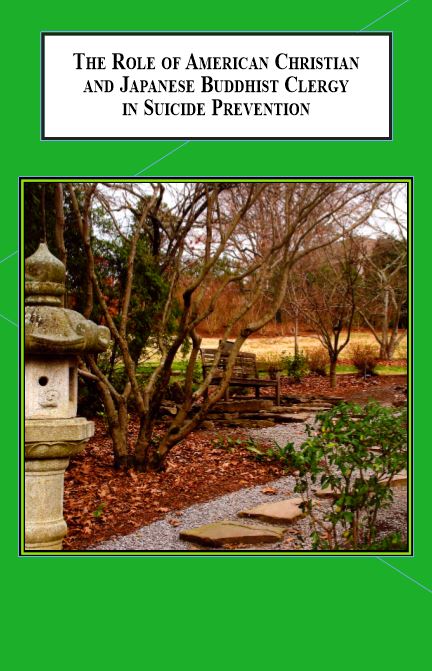The Role of American Christian and Japanese Buddhist Clergy in Suicide Prevention
We are currently unable to ship to the EU countries at this time. We apologize for this inconvenience.

| Author: | Hirono, Tatsushi | |
| Year: | 2012 | |
| Pages: | 236 | |
| ISBN: | 0-7734-2603-5 978-0-7734-2603-0 | |
| Price: | $179.95 + shipping | |
| (Click the PayPal button to buy) | ||
The purpose of this study is to examine American and Japanese clergy’s perception of their role in the prevention of suicide. The research questions are: (1) How do clergy in the US and Japan perceive suicide?; (2) Do they see suicide differently?; and (3) How do they envision the role of suicide prevention? The hypotheses are: (A) Christian clergy think that suicide is an unacceptable “sin;” (B) Buddhist clergy are more accepting of suicide than Christian clergy; and (C) There are role differences related to suicide prevention in the Japanese and American religious communities; and (D) American and Japanese religious leaders have a different view of their obligations related to suicide prevention. The investigator sent 400 anonymous mail surveys respectively to New York and Tokyo. The surveys asked about the clergy’s personal beliefs and the Church’s role in suicide prevention. The investigator analyzed the responses using both quantitative and qualitative methods. The major findings are that many American Christian clergy consider suicide to be a sin; but that “God’s love is available for people who committed suicide.” Many Japanese Buddhist clergy think how one dies is not the most important issue.
Reviews
“The combination of an original topic, the blend of quantitative and qualitative research, and an international comparative study makes [the author]’s book well worth reading. It is for all these reasons that I commend it to your attention.” – Prof. Joel Blau, Stony Brook University
Table of Contents
Forward by Dr. Joel Blau
Preface
Acknowledgments
Chapter 1: The Role of Clergy
Literature Review
Religious and Cultural Features of Suicide
Religious and Cultural Theories of Suicide
Statement of the Problem
Chapter 2: Using Both Quantitative and Qualitative Methods
Introduction
Combining both Quantitative and Qualitative Methods
The Sample
Sampling Procedure
Approval from the Stony Brook University Committee on Research Involving Human Subjects (IRB)
Sample Profile
Asked both Close-ended and Open-ended Questions
Social Indicators: Variables of Suicide Factor
Summary
Chapter 3: Clergy’s Views on Prevention, Obligation, Sin, Counseling, and Resources: Results of the Quantitative Analysis
Introduction
Result of Quantitative Analysis
Summary
Chapter 4: Analyzing “Why” and “Where” Cultural/Religious Differences Come From: Results of the Qualitative Questions
Introduction
Results of the Qualitative Questions
Summary
Chapter 5: Discussion by Analyzing Closed-ended Questions
Introduction
Sin or not Sin?
Obligation to Help or Not?
Can Pastoral Counseling Prevent Suicide?
Social Factors of Suicide
Counseling
Training Experiences
Chapter 6: Discussion by Analyzing Open-ended Questions
Introduction
Analyzing Open-ended Questions
“Hope” is the Key Word for American Christian Clergy
“Life is a Gift from Buddha” is a Common Belief for Japanese Buddhist Clergy
Common Belief: Buddhist Believers Have a Right to Choose Suicide
Common Feature: There is a Lack of Training and Confidence among Buddhist Clergy
Common Beliefs: Reincarnation, Going to Heaven Hell, and En (Fate)
Summary
Chapter 7: Conclusion: Policy Implications, and Limitation of Research
Introduction
Health and Mental Health Implications
Policy Implications
Limitation of this Research and Suggestion for Further Research
Conclusion
References
Name Index
Subject Index
Appendix: Questionnaire in English
Appendix: Questionnaire in Japanese
Preface
Acknowledgments
Chapter 1: The Role of Clergy
Literature Review
Religious and Cultural Features of Suicide
Religious and Cultural Theories of Suicide
Statement of the Problem
Chapter 2: Using Both Quantitative and Qualitative Methods
Introduction
Combining both Quantitative and Qualitative Methods
The Sample
Sampling Procedure
Approval from the Stony Brook University Committee on Research Involving Human Subjects (IRB)
Sample Profile
Asked both Close-ended and Open-ended Questions
Social Indicators: Variables of Suicide Factor
Summary
Chapter 3: Clergy’s Views on Prevention, Obligation, Sin, Counseling, and Resources: Results of the Quantitative Analysis
Introduction
Result of Quantitative Analysis
Summary
Chapter 4: Analyzing “Why” and “Where” Cultural/Religious Differences Come From: Results of the Qualitative Questions
Introduction
Results of the Qualitative Questions
Summary
Chapter 5: Discussion by Analyzing Closed-ended Questions
Introduction
Sin or not Sin?
Obligation to Help or Not?
Can Pastoral Counseling Prevent Suicide?
Social Factors of Suicide
Counseling
Training Experiences
Chapter 6: Discussion by Analyzing Open-ended Questions
Introduction
Analyzing Open-ended Questions
“Hope” is the Key Word for American Christian Clergy
“Life is a Gift from Buddha” is a Common Belief for Japanese Buddhist Clergy
Common Belief: Buddhist Believers Have a Right to Choose Suicide
Common Feature: There is a Lack of Training and Confidence among Buddhist Clergy
Common Beliefs: Reincarnation, Going to Heaven Hell, and En (Fate)
Summary
Chapter 7: Conclusion: Policy Implications, and Limitation of Research
Introduction
Health and Mental Health Implications
Policy Implications
Limitation of this Research and Suggestion for Further Research
Conclusion
References
Name Index
Subject Index
Appendix: Questionnaire in English
Appendix: Questionnaire in Japanese
